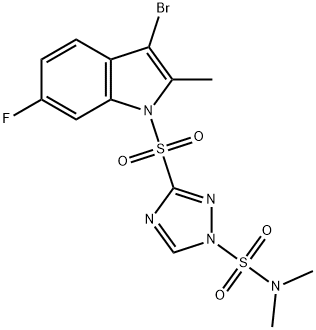348635-87-0

CHEMICAL AND PHYSICAL PROPERTIES
| Color/Form | Fine powder |
|---|---|
| Odor | Odorless |
| Melting Point | 128.6-130.0 °C |
| Solubility | In water, 0.11 g/L at 20 °C, pH 9 |
| Density | 1.61 at 20 °C |
| Vapor Pressure | 1.8X10-5 mPa /1.35X10-10 mm Hg/ at 25 °C |
| LogP | log Kow = 4.4 |
| Henry's Law Constant | Henry's Law constant = 2.8X10-5 Pa /2.1X10-7 atm-cu m/mol/ at 25 °C |
| pH | pH = 6.1, 1% suspension |
SAFETY INFORMATION
| Signal word | Warning |
|---|---|
| Pictogram(s) |
 Exclamation Mark Irritant GHS07  Health Hazard GHS08  Environment GHS09 |
| GHS Hazard Statements |
H319:Serious eye damage/eye irritation H351:Carcinogenicity H410:Hazardous to the aquatic environment, long-term hazard |
| Precautionary Statement Codes |
P201:Obtain special instructions before use. P202:Do not handle until all safety precautions have been read and understood. P264:Wash hands thoroughly after handling. P264:Wash skin thouroughly after handling. P273:Avoid release to the environment. P305+P351+P338:IF IN EYES: Rinse cautiously with water for several minutes. Remove contact lenses, if present and easy to do. Continuerinsing. P308+P313:IF exposed or concerned: Get medical advice/attention. |
COMPUTED DESCRIPTORS
| Molecular Weight | 466.3 g/mol |
|---|---|
| XLogP3 | 2.4 |
| Hydrogen Bond Donor Count | 0 |
| Hydrogen Bond Acceptor Count | 8 |
| Rotatable Bond Count | 4 |
| Exact Mass | 464.95764 g/mol |
| Monoisotopic Mass | 464.95764 g/mol |
| Topological Polar Surface Area | 124 Ų |
| Heavy Atom Count | 26 |
| Formal Charge | 0 |
| Complexity | 741 |
| Isotope Atom Count | 0 |
| Defined Atom Stereocenter Count | 0 |
| Undefined Atom Stereocenter Count | 0 |
| Defined Bond Stereocenter Count | 0 |
| Undefined Bond Stereocenter Count | 0 |
| Covalently-Bonded Unit Count | 1 |
| Compound Is Canonicalized | Yes |
PRODUCT INTRODUCTION
description
Amisulbrom is a member of the class of bromoindoles that is 3-bromo-6-fluoro-2-methylindole substituted at position 1 by a 1-(dimethylsulfamyl)-1,2,4-triazole-3-sulfonyl group. A fungicide for use on potatoes to control late blight (Phytophthora infestans) and downy mildew [Plasmopara viticola). It has a low mammalian toxicity but it is considered to be a reproduction toxicant, is moderately toxic to birds and honey bees but poses a greater risk to aquatic species and earthworms. It has a role as a mitochondrial cytochrome-bc1 complex inhibitor and an antifungal agrochemical. It is a member of sulfamides, a sulfonamide, a member of triazoles, an organofluorine compound, a bromoindole, a sulfonamide fungicide and a triazole fungicide.